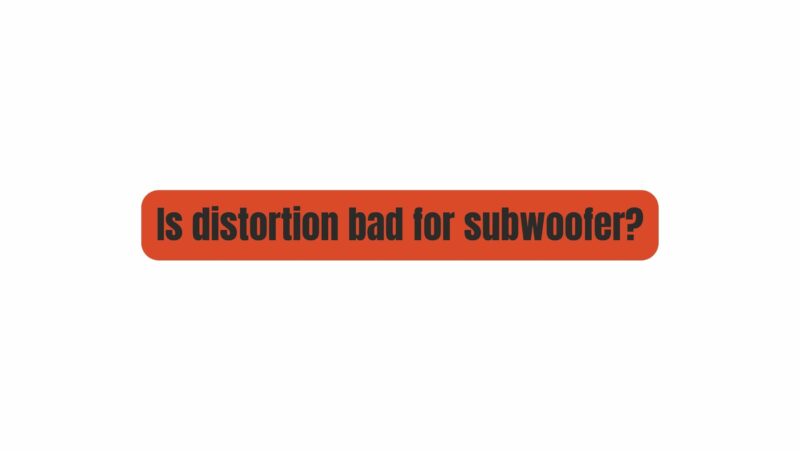Subwoofers are the powerhouse of low-frequency sound reproduction, enhancing the audio experience in home theaters, car audio systems, and live music events. However, subwoofers, like any other audio equipment, are not immune to the effects of distortion. In this in-depth article, we will explore the world of subwoofers and distortion, discussing what distortion is, how it impacts subwoofers, the different types of distortion, and strategies to preserve the health and longevity of your prized subwoofer.
Understanding Distortion
Before we delve into the relationship between distortion and subwoofers, it is essential to comprehend what distortion is and how it occurs in audio systems.
Distortion, in the context of audio, refers to any alteration or deviation from the original audio signal. It results in the generation of unwanted harmonics or frequencies that were not present in the original audio source. Distortion can manifest in various ways, each with its unique characteristics. Here are some common types of distortion:
- Clipping Distortion: Clipping distortion occurs when the amplifier or subwoofer driver is pushed beyond its limits. When the amplitude of the audio signal exceeds the maximum capacity of the system, it gets “clipped,” causing the waveform to flatten or clip. This results in a harsh, grating sound and is often associated with damaged equipment.
- Harmonic Distortion: Harmonic distortion involves the creation of additional frequencies that are integer multiples of the original signal’s frequency. These harmonics can make the audio sound unnatural or unpleasant, affecting the overall listening experience.
- Intermodulation Distortion: Intermodulation distortion arises when two or more frequencies interact within a subwoofer or amplifier, creating sum and difference frequencies. This type of distortion can produce unwanted sounds and artifacts in the audio.
The Impact of Distortion on Subwoofers
Now that we understand what distortion is, let’s explore how it can affect subwoofers specifically. Subwoofers are designed to reproduce low-frequency audio, and their components are engineered to handle the unique challenges of deep bass reproduction. However, distortion can still have several negative consequences for subwoofers:
- Voice Coil and Suspension Stress: The voice coil and suspension components of a subwoofer are particularly vulnerable to the effects of distortion. Clipping distortion, where the audio signal exceeds the subwoofer’s capacity, can cause the voice coil to overheat. Over time, this can lead to voice coil failure or even damage to the suspension components.
- Mechanical Wear and Tear: Subwoofers are equipped with diaphragms and cones that move back and forth to produce sound. Excessive distortion can place additional mechanical stress on these components, leading to physical damage, such as tears in the diaphragm or separation of the suspension.
- Reduced Longevity: While occasional exposure to distortion may not immediately harm a subwoofer, prolonged exposure can lead to wear and tear, reducing its lifespan. Subwoofers are designed to handle clean, undistorted signals within their specified power limits.
Preventing Subwoofer Damage from Distortion
To safeguard your subwoofer from damage caused by distortion, consider implementing the following precautions:
- Amplifier Match: Ensure that the amplifier you use is well-matched to your subwoofer’s specifications. Using an amplifier with a power output within the subwoofer’s recommended range reduces the risk of distortion-related damage.
- Volume Control: Avoid pushing the volume to its maximum levels, especially with low-quality audio sources. High volumes can introduce distortion, which, over time, can harm your subwoofer.
- Use Quality Audio Sources: Utilize high-quality audio sources and recordings. Poorly encoded or highly compressed audio files are more likely to introduce distortion during playback.
- Signal Processing: Consider using signal processing tools, such as limiters or compressors, to prevent excessive peaks in audio signals. These tools can help mitigate the risk of clipping distortion.
- Regular Maintenance: Periodically inspect your subwoofer for any signs of damage or wear. If you notice any issues, address them promptly to prevent further damage.
Conclusion
In conclusion, distortion can indeed be detrimental to a subwoofer if not managed properly. While subwoofers are designed to handle low-frequency audio and the challenges that come with it, continuous exposure to distortion can result in damage to critical components and a decrease in performance. By understanding the relationship between distortion and subwoofers and following the precautions outlined in this article, you can enjoy powerful and accurate bass reproduction while preserving the health and longevity of your subwoofer. Remember that a well-maintained subwoofer will provide years of exceptional low-frequency audio quality.


